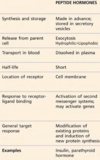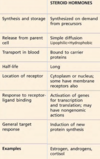7.01 Overview of Endocrine Control Flashcards
(48 cards)
Define endocrinology
The study of the homeostatic mechanisms that are controlled by hormones
Define Hormone
A blood‐borne chemical mediator released from endocrine glands that act on distant target cells
What is the main group of hormones released by the hypothalamus?
Describe its main target and effect
Tropic hormones (hormones that affect the activity of other hormones)
They target the anterior pituitary to release or inhibit pituitary hormones
(Note: many of them are also trophic meaning that they elicit a growth effect on their target cells causing hyperplasia and hypertrophy)
What is the major guide for classification of hormones?
The structure of a hormone
Define the following:
- Endocrine
- Neurocrine
- Autocrine
- Paracrine
- Endocrine: a chemical mediator that travels through the blood strem to act on a distant target (ie. a hormone)
- Neurocrine: a chemical mediator that acts on adjacent cells with a nervous input (action potential (ie. neurotransmitters)
- Autocrine: a chemical messenger that acts on the same cell that secreted it (self-reacting)
- Paracrine: a chemical messenger that acts on the cells very locally

Compare and contrast the nervous system with the endocrine system by filling in the following table:


There is a lot of overlap in the endocrine system. What are four general principles that relate to this?
- One particular endocrine gland may produce multiple hormones (eg. pituitary)
- Hormones may be produced by multiple endocrine glands (eg. sex steroids)
- Hormones may have more than one target and function (sex steroids, GH)
- A single cell/ organ may be influenced by more than one hormone (pancreas, reproductive)
Is the rate of hormone secretion always tonic?
No
- Rate of secretion is highly controlled and stimualated by many sources and trophic hormones
- Rate of secretion of some hormones varies over time in a cyclic pattern (sex steroids)
What is an example of a chemical messenger that may be hormone or neurotransmitter?
Noradrenaline
Are hormones specific for targets or do they act globally to where they can access via the bloodstream?
Hormones will only have affect on target cells that express specific receptors for them (ie. if they are able to be recognised by cells)
A cell without a receptor, will have no response

How does the solubility profile of a hormone impact on its action?
Lipophilic/Hydrophobic
- Means that it is able to easily diffuse through membranes and thus often have intracellular receptors
- Also means it requires protein carriers in the blood
Hydrophilic = Lipophobic
- Means that it requires endocytosis in the cells requiring an extracellular/membrane bound receptor
What is a neurohormone?
Chemical messengers that are released by neurons directly into the bloodstream to act on distant targets - neurocrine action

What are the three main groups of neurohormones?
- Hypothalamus neurohormones acting on the Anterior Pituitary.
- Hypothalamus neurons acting on the Posterior Pituitary.
- Catecholamines (made by modified adrenal medulla neurons).
What is a tropic hormone?
A hormone that controls the secretion of another hormone (trophic usually stimulates growth & development)
– Often (not always) have names that end with tropin Eg. Thyrotropin (TSH), Corticotropin, ACTH, etc.
Draw the simple neural reflex

Draw a simple neurohormonal reflex

Make sure you understand the following images (neuroendocrine pathways)

These are all varying complexities of neuroendocrine reflexes
What makes the simple endocrine pathways unique? How common are they?

They have no neuronal involvement at all
They are quite rare
What are the four main schemes of classifying hormones? Give examples
- Source of Hormone
•eg. pituitary
- Hormone Structure
• eg. Peptides, Amines, Steroids
- Hormone Solubility
• eg. hydrophilic or lipophilic
- Binding of Receptor Type
• eg. G protein‐coupled receptors, tyrosine kinase‐linked receptors etc
What are the three main classifications based on the structure?
- Peptide
- Steroid
- Amine (catecholamines and thyroid hormones)
Hydrophobic/lipophillic hormones travel through the blood often bound to protein carriers. What does this achieve?
- It enables a specificity to the hormones
- Increases half-life
Describe the synthesis pathway of a peptid hormone
- Messenger RNA on ribosomes bind amino acids into a peptide chain = preprohormone that is directed to the ER
- Enzymes in the ER cleave off the signal sequence creating an inactive prohormone
- The prohormone passes through the golgi complex
- They are packed and stored in secretory vesicles that contain the enzymes and the prohormone. The enzymes cleave the prohormone into one or more active peptides
- A release signal comes in causing exocytosis of vesicle contents into the extracellular space
- Hormones move into the circulation for transport to the target

Fill in the following table about peptide hormones


What is common to all steroid hormones in terms of their synthesis?
Give examples of steroid hormones
All steroid hormones start from cholesterol (it is the background structure). Depending on the enzymes in various tissues, gives the final steroid hormone:
- Adrenal cortex: aldosterone and cortisol
- Ovaries: oestrogen













